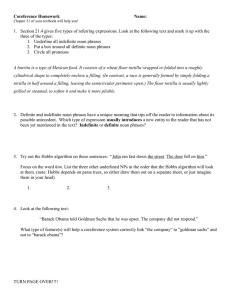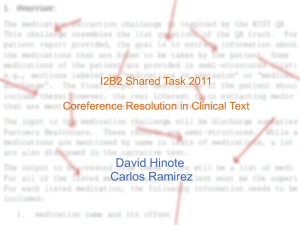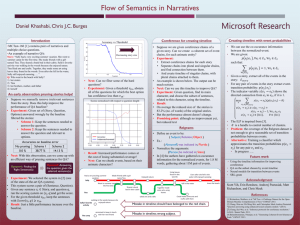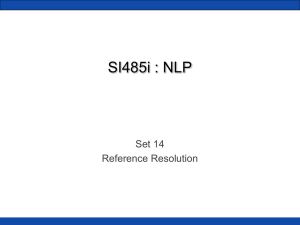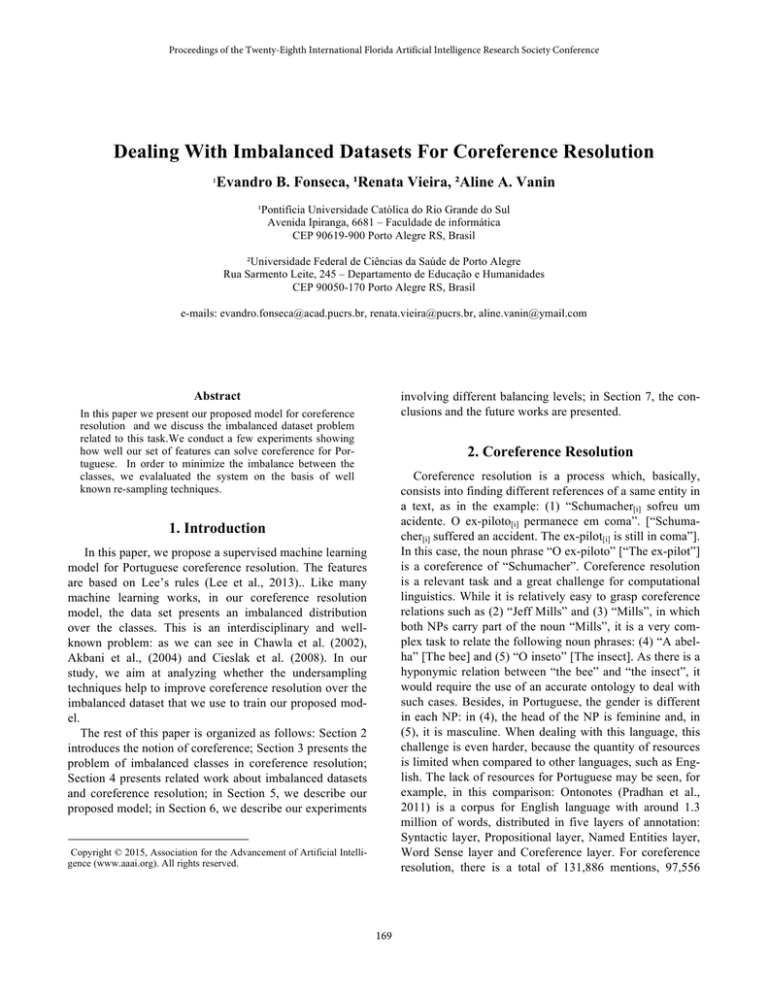
Proceedings of the Twenty-Eighth International Florida Artificial Intelligence Research Society Conference
Dealing With Imbalanced Datasets For Coreference Resolution
¹Evandro
B. Fonseca, ¹Renata Vieira, ²Aline A. Vanin
¹Pontifícia Universidade Católica do Rio Grande do Sul
Avenida Ipiranga, 6681 – Faculdade de informática
CEP 90619-900 Porto Alegre RS, Brasil
²Universidade Federal de Ciências da Saúde de Porto Alegre
Rua Sarmento Leite, 245 – Departamento de Educação e Humanidades
CEP 90050-170 Porto Alegre RS, Brasil
e-mails: evandro.fonseca@acad.pucrs.br, renata.vieira@pucrs.br, aline.vanin@ymail.com
Abstract
involving different balancing levels; in Section 7, the conclusions and the future works are presented.
In this paper we present our proposed model for coreference
resolution and we discuss the imbalanced dataset problem
related to this task.We conduct a few experiments showing
how well our set of features can solve coreference for Portuguese. In order to minimize the imbalance between the
classes, we evalaluated the system on the basis of well
known re-sampling techniques.
2. Coreference Resolution
Coreference resolution is a process which, basically,
consists into finding different references of a same entity in
a text, as in the example: (1) “Schumacher[i] sofreu um
acidente. O ex-piloto[i] permanece em coma”. [“Schumacher[i] suffered an accident. The ex-pilot[i] is still in coma”].
In this case, the noun phrase “O ex-piloto” [“The ex-pilot”]
is a coreference of “Schumacher”. Coreference resolution
is a relevant task and a great challenge for computational
linguistics. While it is relatively easy to grasp coreference
relations such as (2) “Jeff Mills” and (3) “Mills”, in which
both NPs carry part of the noun “Mills”, it is a very complex task to relate the following noun phrases: (4) “A abelha” [The bee] and (5) “O inseto” [The insect]. As there is a
hyponymic relation between “the bee” and “the insect”, it
would require the use of an accurate ontology to deal with
such cases. Besides, in Portuguese, the gender is different
in each NP: in (4), the head of the NP is feminine and, in
(5), it is masculine. When dealing with this language, this
challenge is even harder, because the quantity of resources
is limited when compared to other languages, such as English. The lack of resources for Portuguese may be seen, for
example, in this comparison: Ontonotes (Pradhan et al.,
2011) is a corpus for English language with around 1.3
million of words, distributed in five layers of annotation:
Syntactic layer, Propositional layer, Named Entities layer,
Word Sense layer and Coreference layer. For coreference
resolution, there is a total of 131,886 mentions, 97,556
1. Introduction
1
In this paper, we propose a supervised machine learning
model for Portuguese coreference resolution. The features
are based on Lee’s rules (Lee et al., 2013).. Like many
machine learning works, in our coreference resolution
model, the data set presents an imbalanced distribution
over the classes. This is an interdisciplinary and wellknown problem: as we can see in Chawla et al. (2002),
Akbani et al., (2004) and Cieslak et al. (2008). In our
study, we aim at analyzing whether the undersampling
techniques help to improve coreference resolution over the
imbalanced dataset that we use to train our proposed model.
The rest of this paper is organized as follows: Section 2
introduces the notion of coreference; Section 3 presents the
problem of imbalanced classes in coreference resolution;
Section 4 presents related work about imbalanced datasets
and coreference resolution; in Section 5, we describe our
proposed model; in Section 6, we describe our experiments
1
Copyright © 2015, Association for the Advancement of Artificial Intelligence (www.aaai.org). All rights reserved.
169
links and 34290 chains; Harem corpus (Freitas, 2010), for
Portuguese, has around 225 thousand words, distributed in
three layers: Coreference layer, Relation between Named
Entities layer (4803 marks) and Semantic Category layer
(7847 recognized named entities).
Although it is at an early stage of development, the research for coreference resolution in Portuguese should be
pursued, as it is quite relevant for many other tasks. Gabbard et al. (2011) show that coreference resolution may
provide meaningful gains for the relation extraction among
named entities, since the coreference links may be useful
for extracting sets of implicit relations. Consider the following sentence: (6) “José da Silva mora perto do Centro,
em Porto Alegre. O aluno está no primeiro ano de seu
mestrado na PUCRS”. [José da Silva lives close to the
Downtown area. The student is taking his first year of
Masters at PUCRS]. When identifying and creating a coreference relation between “José da Silva” and “student”, it
is possible to infer a direct relation between the entities
“José da Silva” and “PUCRS” (in which José da Silva is a
student at PUCRS). In other words, when we say that José
da Silva is a student, it is possible to classify him as a person, as well as to say that he has relation with PUCRS.
Research on relation extraction is being conducted for
Portuguese (Abreu et al. ,2013). In this work the recognition of relations among named entities such as Person,
Location and Organization could benefit from our research
on coreference resolution.
Table 1: Candidate pairs.
NP(x)
o agrônomo
NP(y)
Miguel Guerra
Coreference
Yes
o agrônomo
a UFSC
No
o agrônomo
Universidade Federal de
Santa Catarina
a UFSC
No
Universidade Federal de
Santa Catarina
Universidade Federal de
Santa Catarina
No
Miguel Guerra
Miguel Guerra
UFSC
No
Yes
Each noun phrase forms a pair with the next one, but
never with the previous one, like the method used by Fonseca et al., (2013). Note that the quantity of negative examples in this little text fragment is 2 negative pairs for
each positive one. Using the Summ-it corpus (Collovini et
al., 2007) to build our supervised coreference dataset, this
proportion has achieved 31 to 1.
Learning in presence of imbalanced datasets is an important issue in machine learning. Learning algorithms
incorporate the assumption that maximizing the overall
accuracy is the goal. However, in many cases this does not
meet the goals and requirements of an application and the
results are unsatisfactory classifiers. In coreference resolution, for example, we prioritize the positive class. In other
words, we try to minimize the false positives. A common
way to deal with imbalanced data is to artificially change
the data set distribution by oversampling or/and undersampling. Oversampling consists in replicating some of the
training examples of the minority class until the desired
class distribution is reached..While the undersampling
consists in removing some training examples of the majority class. There are many techniques for selecting the training examples that should be replicated or deleted. The most
popular method is random selection. Both techniques have
correlated problems: undersampling can eliminate potentially useful examples of data, while the oversampling may
increase the probability of occurrence of an overfitting,
since the most accurate oversampling methods are examples of the minority class copies. In this sense, a symbolic
model classification, for example, could build rules that are
seemingly accurate, but actually cover replicated examples.
Some recent researches are focused on trying to overcome these problems for these two classes of methods. An
example of this is Chawla’s research (2002), which combines sampling techniques, and, instead of a simple oversampling replication of the minority class, they do the
interpolation of pixels (in this case, the interpolation consists into a randomly replication of the “x” neighbors from
each sample). Thus, the overfitting is minimized and the
boundaries of decision to the minority class are extended.
3. The Imbalanced Class Problem in
Coreference Resolution
The imbalance class problem typically occurs when, in a
classification problem, there are many more instances of
some classes than others. In such cases, the standard classifiers tend to favor the majority class ignoring the small
ones. In practical applications, the number of imbalanced
instances can be drastic, such as 1 to 100, 1 to 1000 or 1 to
10000 (sometimes even more) (Chawla et al., 2004). This
problem is prevalent in many applications, including:
fraud/intrusion detection, risk management, text classification, and medical diagnosis/monitoring and others. For the
coreference resolution, for example, this proportion also
exists. Given the text fragment: “A opinião é do agrônomo
Miguel Guerra, da UFSC (Universidade Federal de Santa
Catarina), [...]” [“The agronomist Miguel Guerra’s opinion, from UFSC (Federal University of Santa Catarina),
[…]”], we must cross all noun phrases, generating the
candidate pairs, as in Table 1:
170
Another technique, which may improve the balance
among the classes, is the cost-sensitive learning: the training examples assign relative costs, called misclassification
costs. The idea is to set high costs for the examples of the
minority class and lower costs for the examples of the
majority class. The goal of learning algorithms is to minimize the total costs that would result from classifying the
training examples. This approach requires a cost-sensitive
implementation of a particular learning algorithm. However, appropriate oversampling can have the same effect
(Cimiano, 2006).
The variation of threshold may be an efficient technique,
too: the method consists into varying the classifier threshold. Internally, learning algorithms estimate the probability
that an example is assigned to each class (probabilistic
class distribution). Basically, the class having the highest
probability is normally assigned. Thus, a binary classifier
chooses that class that has a probability greater than 0.5. If
this value is increased for the majority class, the threshold
to assign the majority class is higher and the classifier will
probably assign the minority class. Sebastiani et al. (2002)
perform a distinction between the forms to derive a value
for the threshold analytically (through known metrics) and
experimentally (tuning the threshold).
In our study we evaluate the impact of the undersampling
technique, avoiding the effect of overfitting caused by the
oversampling.
the sophisticated sampling techniques did not give any
clear advantage in the considered domain.
Estabrooks et al. (2004) propose experiments involving
different levels of undersampling and oversampling. In this
research, they concluded that neither the oversampling nor
undersampling strategies are always the best ones to use.
Finding a way to combine them could – perhaps – be useful, especially if the bias resulting from each strategy has a
different nature.
Chawla et al. (2002) proposes a method called SMOTE
(Synthetic Minority Oversampling Technique). This technique consists of creating new instances through interpolation. For each positive instance, its nearest positive neighbors were identified and new positive instances were created and placed randomly in between the instance and its
neighbors.
Ling and Li (1998) have combined over-sampling of the
minority class with under-sampling of the majority class,
showing that the over and undersampling techniques combination did not provide a significant improvement.
In this paper, we describe experiments involving resampling techniques, aiming to increase the performance
of our coreference resolution model.
4.2 Coreference Resolution:
Coreference resolution is a well-known NLP problem. In
the literature, we find works that are based only in rules,
and others that are based only on machine learning. At the
Conference on Computational Natural Language Learning
(CoNLL 2011), Lee et al. (2011) presented a system that is
purely based on rules for coreference resolution in English.
The Sanforfd’s Multi-Pass Sieve Coreference Resolution
System, which is purely deterministic, reached an efficiency of 57.79%, and this was measured by the average rate
among three performance metrics (MUC, B-CUBED and
CEAFe), described in Pradhan et al. (2011). In his most
recent publication, Lee et al. (2013) present a system in a
more specific way, describing the 10 Sieves. Each sieve
links the mentions until that specific rules be satisfied.
Coreixas (2010) proposes a coreference resolution system for Portuguese (PT-BR), with focuses on categories of
named entities. According to the author, works related to
English have had successful results when using specific
categories of entities. Based on these assumptions, Coreixas hypothesized that the use of specific categories of
named entities has a positive impact on the task of coreference resolution, since each category has distinct and welldefined characteristics. As the categorization defines the
field, the use of semantic information as a support tool in
the coreference resolution process becomes more feasible.
Coreixas’ system was based on machine learning, categorization of named entities, such as Person, Organization,
Location, Work, Thing and Other (from the corpus of
4. Related work
In this section we describe related works that deal with
imbalanced dataset and coreference resolution.
4.1 Imbalanced Dataset
Japkowicz (2000) discusses the effect of imbalance in a
dataset. The author has evaluated three strategies:
Resampling, Down-Sizing and Learning by recognition. In
Resampling, two resampling methods were considered in
this category. Random resampling consists in resampling
the smaller class at random until it consists of as many
samples as the majority class, and focused resampling
consists of resampling only those minority examples that
occur on the boundary between the minority and majority
classes. Down-Sizing consists in two down-sizing methods, closely related to the re-sampling methods. The first
one, rand_downsize, consists of eliminating randomly
elements of the over-sized class until it matches the size of
the minority class. The second one, focused_downsize,
consists of eliminating only further away elements. Learning by Recognition strategy consists of using a trained
Multilayer Perceptron algorithm, in order to auto associate
the samples. Japkowicz noted that both the sampling approaches were effective, and she also observed that using
171
HAREM (Freitas et al., 2010)), the parser PALAVRAS
(Bick, 2000) and the resource from Summ-it corpus (Collovini et al., 2007). Coreixas compares two versions of the
system, namely: Baseline and "Recorcaten" (REsolução de
CORreferência por CATegorias de ENs, meaning coreference resolution by named entities categories). The first
version aimed at generating pairs of phrases without considering the categories of NEs. The second generates pairs
considering these types of entities. As a contribution,
through experiments with both versions, Coreixas showed
that the use of categories of entities provided an improvement in the percentage of correct answers to determine
whether a pair is anaphoric or not. Also, it showed the
importance of world knowledge for this line of research,
given the fact that some categories, such as Event and
Organization, did not show a satisfactory return on the
classification of coreferent pairs. This happens because the
process of disambiguation was not performed correctly,
thus emphasizing the importance of databases with synonyms, such as Wordnet (Miller, 1995), to complement and
support the resolution of coreference. This work has limitations: (a) the size of the corpus used in the experiments is
not very big (it has only fifty texts); (b) there are not many
resources for Portuguese; (c) according to Coreixas, the
parser presents several problems of annotation.
Fonseca et al. (2013) proposes a coreference resolution
system for Portuguese (PT-BR) using supervised machine
learning. Their system has a total of 9 features. The author
has focused only in pairs whose NPs were proper nouns,.
In our current work we combine features previously proposed in Fonseca et al. (2013) and Lee et al.’s (2013) established rules. In this work we consider all noun phrases
pairs..To study the imbalance problem, we ran a few experiments, aiming to find the best balance for our algorithm.
or has a subset of the NP1 modifiers. Ex: [the correct runway]… [the wrong runway], in this case, returning false;
(4) Not_IwithinI: If a mention is not in an IwithinI construction. Ex: for [The boy with a brown t-shirt ] …[the
brown t-shirt], the feature returns false, because the NPs
are
in
IwithinI
construction;
(5)
Proper_Head_Word_Match: This feature returns true if three
conditions are satisfied: Both NPs must be proper nouns,
the heads of the NPs must share some same elements and
these NPs are not in IwithinI construction Ex: [Adalberto
Portugal] and [Portugual] for this case, this feature return
false, because the NPs is in a IwithinI construction ; (6)
Alias: If one of the words from NP1 is acronym of NP2;
(7) Gender: If the phrases agree in gender (male/female);
(8) Number: If the phrases agree in number (singular/plural); (9) Semantic_Categ_Eq: If the categories of
entities (Person, Location or Organization) are equal; (10)
Semantic_Categ_Dif: If the categories (Person, Location
or Organization) are different. When the category is unknown, both Semantic_Categ_Eq and Semantic_Categ_Dif
are false; (11) NP_Distance: The distance between NP1
NP2 in number of NPs (12) Sentence_Distance: The
number of sentences between NP1 and NP2 is counted.
The construction of NP pairs was based on coreference
information contained in the Summ-it (Collovini et al.,
2007) corpus. To create the pairwise, we use Fonseca et
al.’s (2013) strategy: each noun phrase makes pair with the
next one, never with the previous one. In order to provide
the semantic categories, we use PALAVRAS (Bick, 2000).
Using the Summ-it corpus as input, we obtained a dataset
consisting of 3022 coreferent pairs and 94889 noncoreferent pairs. If we divide these results in the original
dataset, we have 31 negative pairs for each positive one
(94889/3022= ~31). We decided to run this imbalanced
dataset on Weka API (Boukckaert et al., 2013) in order to
create a baseline margin. For this and other experiments,
we use the J48 decision tree. We chose this algorithm because in balancing tests it presented the best results. The
results can be seen in the confusion matrix (Table 2):
5. The Proposed Model
This section describes the resources and the set of implemented features. The resources used in the construction
of our coreference resolution model are: Corpus Summ-it
(Collovini et al., 2007); the Portugues parser PALAVRAS,(Bick, 2000) for named entity recognition; and
Weka (Boukckaert et al., 2013), a collection of machine
learning algorithms.
We implemented twelve features, as follows below.
They are an adaptation for Portuguese of Lee et al.
(2013)’s along with features from Fonseca et al. (2013).
(1)Exact_String_Match: If the two NPs are exactly the
same, Ex: [The agronomist] [The agronomist]; (2) Relaxed_String_Match: If the strings obtained by dropping
the text following the heads are identical. Ex: [The museum of Porto Alegre]... [the museum]; (3)
Word_Inclusion: If NP2 has the same modifiers of NP1
Table 2: Confusion Matrix of J48.
172
-
P
N
P
927
2095
N
321
94568
In Tables 4 and 5, respectively, we can see the results
from positive and negative classes. The quantity of positive
pairs extracted from Summ-it is 3022 (we use all positive
pairs). The class “N” has a total of 94889 pairs, suffering
undersampling in all experiments. Note that the results
from negative class are improved as the number of samples
increase. For the class “P”, the recall and precision are
directly related. That is: if the precision grows, the recall
decreases and vice-versa. We believe that the best results
for the positive class can be achieved in the proportion of 1
to 1 (1 positive pair for each negative one) and 1 to 2 (1
positive pair for each 2 negative ones). This means “1 to 1”
for a more balanced precision and recall; and “1 to 2” for a
more precise classification.
Table 3: Precision, recall and f-measure for Baseline model,
using J48 algorithm.
-
Precision
Recall
F-measure
P
74.3%
30.7%
43.4%
N
97.8%
99.7%
98.7%
In Table 3, we can see that the negative class was privileged because the supervised machine learning algorithms
aim at improving the global accuracy, which is 97.5%.
However, this is not a good result. In coreference resolution, using machine learning, we aim at improving the
positive class, in addition to reducing the false positives. In
this context, the negative class is not so important. Analyzing Table 2, note that, from 3022 positive pairs, we had
2095 false negatives (decreasing the recall of positive
class) and 321 false positives (decreasing its precision).
7. Conclusion
In this paper, we aimed to describe the generation of a
model for solving coreferences in Portuguese, focusing on
categories of named entities and specific features. Our
balancing levels “1 to 1” (1 positive for each negative one)
and “1 to 2” (1 positive for each 2 negative ones) are promising in comparison to our baseline model, in which the
results for the class “P” is 74.3% of precision, 30.7% of
recall and 43.4% of f-measure. In these two balancing
levels, we obtained 79.5% of precision, 56.0% of recall
and 65.6% of f-measure in “1 to 1” proportion and 90.6%
of precision, 40.1% of recall and 55.6% of f-measure in “1
to 2” proportion. The global result is also good, if compared with Fonseca et al.’s work. They focused only in
pairs containing proper nouns in both noun phrases,
achieving a precision of 76.8%, a recall of 88.9% and an fmeasure of 82.4%. In our current work, we increase this
scope, solving co-reference for all noun phrase pairs.
In order to validate our experiments, we ran each of the
five experiments with different under-sampling size 100
times, calculating an average from precision, recall and fmeasure. In our experiments, we proved that the undersampling technique may help coreference resolution, improving the results. As future work, we want to test semantic resources, such as Onto-PT (Oliveira et al., 2014, in
order to introduce a richer semantic discourse at computational level.
6. Experiments
Aiming to improve the results from positive class, a few
experiments were conducted. Each balancing experiment
was run one hundred times, in order to calculate an average
from precision, recall and f-measure. We did five experiments, choosing randomly a different number of samples
from class “N”, as in Tables 4 and 5.
Table 4: Experiment results from P class.
Number of P
and N samples
Avg.
Precision
Avg.
Recall
Avg. F-measure
3022 – 3022
79.5%
56.0%
65.6%
3022 – 6044
90.6%
40.1%
55.6%
3022 – 9066
92.0%
37.7%
53.4%
3022 – 15110
89.9%
36.6%
52.0%
3022 – 30220
85.6%
35.3%
50.0%
Table 5: Experiment results from N class.
Number of P
and N samples
Avg.
Precision
Avg.
Recall
Avg. F-measure
3022 – 3022
66.0%
85.4%
74.4%
3022 – 6044
76.6%
98.0%
85.9%
3022 – 9066
82.6%
98.9%
90.0%
3022 – 15110
88.7%
99.2%
93.6%
References
3022 – 30220
93.9%
99.4%
96.6%
Abreu, S. C., Bonamigo, T. L., and Vieira, R. (2013) A review on
Relation Extraction with an eye on Portuguese, Pages 1-19 In:
Acknowledgements
The authors acknowledge the financial support of CNPq,
CAPES and Fapergs.
173
on entity-centric, precision-ranked rules. Computational Linguistics, 39(4), 885-916.
Ling, C., and Li, C. (1998). Data Mining for Direct Marketing
Problems and Solutions. In Proceedings of the Fourth International Conference on Knowledge Discovery and Data Mining
(KDD-98) New York, NY. AAAI Press.
Japkowicz, N. (2000). The Class Imbalance Problem: Significance and Strategies. In Proceedings of the 2000 International
Conference on Artificial Intelligence (IC-AI’2000): Special Track
on Inductive Learning Las Vegas, Nevada.
Miller, G. (1995) WordNet: A Lexical Database for English. In:
Communications of the ACM Vol. 38, No. 11: 39-41. Available
at: http://dl.acm.org/citation.cfm?id=219748
Oliveira, H. G., & Gomes, P. (2014). ECO and Onto. PT: a flexible approach for creating a Portuguese wordnet automatically.
Language Resources and Evaluation, 48(2), 373-393. Available at
http://link.springer.com/article/10.1007/s10579-013-92499/fulltext.html
Journal of the Brazilian Computer Society. Available at:
http://link.springer.com/article/10.1007%2Fs13173-013-01168#page-1
Akbani, R., Kwek, S., & Japkowicz, N. (2004). Applying support
vector machines to imbalanced datasets. In Machine Learning:
ECML 2004 (pp. 39-50). Springer Berlin Heidelberg.
Bick, E., (2000) The Parsing System “Palavras” - automatic
grammatical analysis of portuguese in a constraint grammar
framework, Tese de Doutorado, Department of Linguistics, University of Århus, DK.
Cimiano, P., (2006). Ontology learning and Population from text.
Algorithms, Evaluation and Applications. University of Karlsruhe
Inst. AIFB, Germany. ISBN 0387306323
Boukckaert, R., Frank, E., Hall, M., Kirkby, K., Reutemann, P.,
Seewald, A. and Scuse, D., (2013) Weka Manual for version
3.6.9,
The
University
of
Waikato.
Available
at:
http://www.cs.waikato.ac.nz/ml/weka/
Chawla, N. V., Bowyer, K. W., Hall, L. O., & Kegelmeyer, W. P.
(2002). SMOTE: synthetic minority over-sampling technique. In
Journal of Artificial Inteligence Research 16:321-357
Chawla, N. V., Japkowicz, N., & Kotcz, A. (2004). Editorial:
special issue on learning from imbalanced data sets. ACM Sigkdd
Explorations Newsletter, 6(1), 1-6.
Cieslak, D. A., & Chawla, N. V. (2008). Learning decision trees
for unbalanced data. In Machine Learning and Knowledge Discovery in Databases (pp. 241-256). Springer Berlin Heidelberg.
Collovini, S., Carbonel, T., Fuchs, J., Coelho, J., Rino, L. and
Vieira, R. (2007) Summ-it: Um corpus anotado com informações
discursivas visando à sumarização automática. In: V Workshop
em Tecnologia da Informação e da Linguagem Humana – TIL.
Proceedings of XXVII Congresso da SBC, Rio de Janeiro.
Coreixas T., Resolução De Correferência E Categorias De Entidades Nomeadas, Dissertação De Mestrado, Pontifícia Universidade Católica Do Rio Grande Do Sul, 2010. Available at:
http://repositorio.pucrs.br/dspace/handle/10923/1567
CoNLL2011, Conference on computational natural language
learning, Available at: http://conll.cemantix.org/2011/. Access on:
05/08/2012.
Estabrooks, A., Jo, T., & Japkowicz, N. (2004). A multiple
resampling method for learning from imbalanced data sets. Computational
Intelligence,
20(1),
18-36.
Available
at
http://150.214.190.154/docencia/doctoM6/Estrabrooks.pdf
Fonseca E. B., Vieira R., Vanin A. (2013), Resolução de Correferência em Língua Portuguesa: Pessoa, Local e Organização. In X
National Meeting on Artificial and Computational Intelligence.
Freitas, C., Mota, C., Santos, D., Oliveira, H. and Carvalho, P.
(2010) Second HAREM: Advancing the State of the Art of
Named Entity Recognition in Portuguese, Linguateca, FCCN.
Gabbard, R., Freedman, M. and Weischedel, R. M. (2011) Coreference for Learning to Extract Relations: Yes, Virginia, Coreference Matters. In: Proceedings 49th Annual Meeting of the Association for Computational Linguistics: shortpapers, pages 288–
293, Portland, Oregon.
Lee, H., Peirsman, Y., Chang, A., Chambers, N., Surdeanu, M.,
Jurafsky, D. (2011) Stanford’s Multi-Pass Sieve Coreference
Resolution System at the CoNLL-2011 Shared Task, Conference
on computational natural language learning.
Lee, H., Chang, A., Peirsman, Y., Chambers, N., Surdeanu, M., &
Jurafsky, D. (2013). Deterministic coreference resolution based
Pradhan, S., Ramshaw, L., Marcus, M., Palmer, M.,
Weischedel, R. and Xue, N. (2011) CoNLL-2011 Shared
Task: Modeling Unrestricted Coreference in OntoNotes,
CoNLL Shared Task.
Sebastiani, F. (2002). Machine learning in automated text
categorization. ACM computing surveys (CSUR), 34(1), 147. Available at: http://arxiv.org/pdf/cs.ir/0110053.pdf
174

